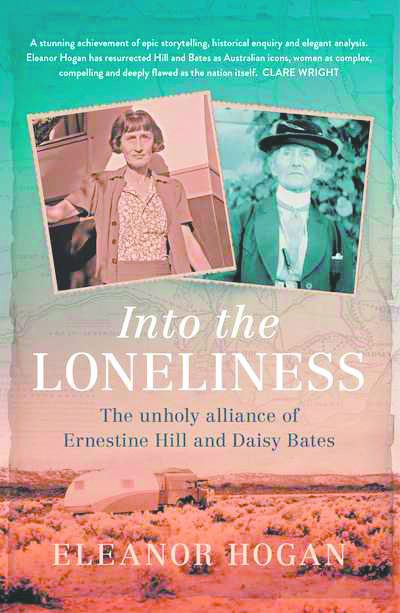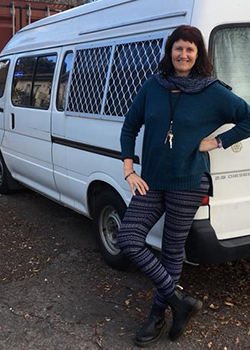Eleanor Hogan
ELEANOR HOGAN IS a literary non-fiction writer who draws on her experience of living and working in Central Australia. Her latest book, Into the Loneliness: The Unholy Alliance of Ernestine Hill and Daisy Bates, is out this month. NT Writers’ Centre caught up with her for a chat.
 Congratulations on your latest book! Can you tell us a bit more about it?
Congratulations on your latest book! Can you tell us a bit more about it?
In 1932, journalist Ernestine Hill travelled to Ooldea on the Eastern side of the Nullarbor to visit Daisy Bates, an anthropologist camping with Aboriginal people. Sensing the potential of Bates’ story, Hill coaxed her down to Adelaide where they collaborated on what became the controversial bestseller, The Passing of the Aborigines. Into the Loneliness reflects on these women’s lives, legacies, and writing about Aboriginal people through a road trip I undertook to retrace their travels across the Nullarbor.
What was the inspiration behind it?
Seven years ago, I stumbled across Ernestine Hill’s The Great Australian Loneliness, which was based on her journalistic wanderings across the country in the 1930s. I was fascinated by her dedication to conveying the richness and diversity of the outback to the urban south. Hill herself was intriguing, knocking about remote Australia in a broad-brimmed hat, shorts and boots, at a time when it was considered dangerous for a woman to travel alone.
While researching in the archives, I stumbled across a bundle of letters from Daisy Bates summoning Ernestine Hill to collaborate on an anthropological work. I had no idea that Hill was a friend of the notorious Bates, and I was struck by the unusualness of two women discussing anthropology together, not to mention their sense of a mandate to record Aboriginal – and also settler – life during this era.
 What were the challenges and rewarding aspects of writing a biography?
What were the challenges and rewarding aspects of writing a biography?
Being honest to what I found through my research, rather than what I expected to find, was both challenging and rewarding. That goes for research generally, but it’s more challenging in biography where the subject matter can be personal and other people are often involved. Technically speaking, a major challenge was integrating the three narrative threads of Hill’s, Bates’ and my stories across different time periods.
Receiving funding support from Australia Council for the Arts and the Peter Blazey and Hazel Rowley fellowships was a great boon, as it also enabled me to retrace some of Bates and Hill’s journeys, and to visit Anangu who’d camped with Bates and their descendants at Yalata. The generosity and warm welcome I received from Yalata community members, who took me to visit the remains of Bates’ camp at Ooldea Soak, was a major highlight of the whole project.
Are you currently working on any other books or writing projects?
I’m currently tinkering with a podcast series, Outlandia, about Central Australian books, history and ideas, for 8CCC. Mid-year, I’m returning to Yalata to record the senior women’s stories. I have an idea for another biography, but I don’t envisage tackling it for several years as I found this one was as much work as my PhD!
If we were to take a look on your bookshelf, what kinds of books would we find there?
You’d find my bookshelves are subdivided into alphabetised sections — fiction, theory, biography, literary nonfiction, poetry, kids’ books, etc. Fiction is my largest section with a mixture of books by contemporary and ‘classical’ literary authors. My favourite shelves at the moment house a collection of early editions of books by ‘vast open space’ writers and Australian anthropologists.
Any Territory writers you’re enjoying at the moment?
I’m enjoying NPY Women’s Council’s Tjanimaku Tjukurpa: How One Young Man Came Good. Next on the list is Evan Reece’s We Sat Where They Sat about his father Laurie Reece’s camel trip into Warlpiri country in 1944. Other recent highlights for me were Dani Powell’s Return to Dust and Tess Lea’s Wild Policy.
INFO newsouthbooks.com.au | facebook.com/alicespringseleanorhogan
